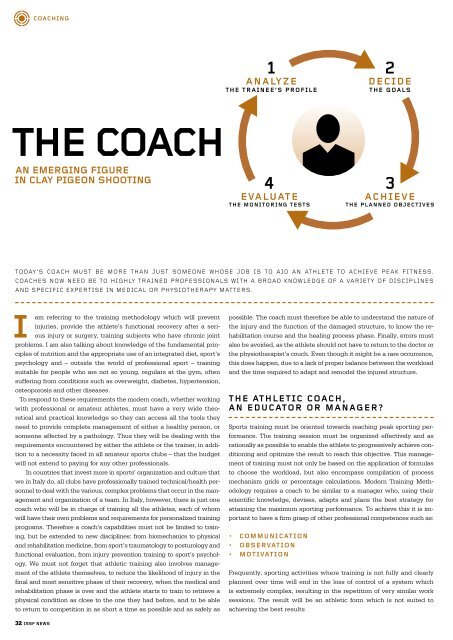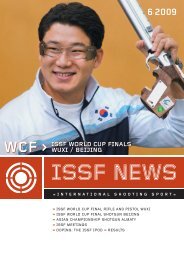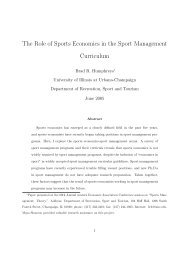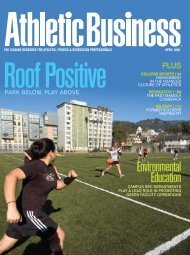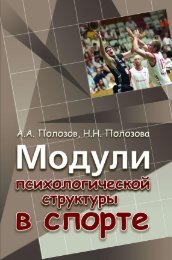You also want an ePaper? Increase the reach of your titles
YUMPU automatically turns print PDFs into web optimized ePapers that Google loves.
I<br />
am referring to the training methodology which will prevent<br />
injuries, provide the athlete’s functional recovery after a serious<br />
injury or surgery, training subjects who have chronic joint<br />
problems. I am also talking about knowledge of the fundamental principles<br />
of nutrition and the appropriate use of an integrated diet, sport’s<br />
psychology and – outside the world of professional sport – training<br />
suitable for people who are not so young, regulars at the gym, often<br />
suffering from conditions such as overweight, diabetes, hypertension,<br />
osteoporosis and other diseases.<br />
To respond to these requirements the modern coach, whether working<br />
with professional or amateur athletes, must have a very wide theoretical<br />
and practical knowledge so they can access all the tools they<br />
need to provide complete management of either a healthy person, or<br />
someone affected by a pathology. Thus they will be dealing with the<br />
requirements encountered by either the athlete or the trainer, in addition<br />
to a necessity faced in all amateur sports clubs – that the budget<br />
will not extend to paying for any other professionals.<br />
In countries that invest more in sports’ organization and culture that<br />
we in Italy do, all clubs have professionally trained technical/health personnel<br />
to deal with the various, complex problems that occur in the management<br />
and organization of a team. In Italy, however, there is just one<br />
coach who will be in charge of training all the athletes, each of whom<br />
will have their own problems and requirements for personalized training<br />
programs. Therefore a coach’s capabilities must not be limited to training,<br />
but be extended to new disciplines: from biomechanics to physical<br />
and rehabilitation medicine, from sport’s traumatology to posturology and<br />
functional evaluation, from injury prevention training to sport’s psychology.<br />
We must not forget that athletic training also involves management<br />
of the athlete themselves, to reduce the likelihood of injury in the<br />
final and most sensitive phase of their recovery, when the medical and<br />
rehabilitation phase is over and the athlete starts to train to retrieve a<br />
physical condition as close to the one they had before, and to be able<br />
to return to competition in as short a time as possible and as safely as<br />
32 ISSF NEWS<br />
COACHING<br />
<strong>THE</strong> COACH<br />
AN EMERGING FIGURE<br />
IN CLAY PIGE<strong>ON</strong> SHOOTING<br />
1<br />
ANALYzE<br />
<strong>THE</strong> TRAINEE’S PROFILE<br />
4<br />
EVALUATE<br />
<strong>THE</strong> M<strong>ON</strong>I<strong>TO</strong>RING TESTS<br />
today’S coach MuSt BE MorE thaN juSt SoMEoNE WhoSE joB iS to aid aN athlEtE to achiEvE PEak FitNESS.<br />
coachES NoW NEEd BE to highly traiNEd ProFESSioNalS With a Broad kNoWlEdgE oF a variEty oF diSciPliNES<br />
aNd SPEciFic ExPErtiSE iN MEdical or PhySiothEraPy MattErS.<br />
possible. The coach must therefore be able to understand the nature of<br />
the injury and the function of the damaged structure, to know the rehabilitation<br />
course and the healing process phase. Finally, errors must<br />
also be avoided, as the athlete should not have to return to the doctor or<br />
the physiotherapist’s couch. Even though it might be a rare occurrence,<br />
this does happen, due to a lack of proper balance between the workload<br />
and the time required to adapt and remodel the injured structure.<br />
<strong>THE</strong> ATHLETIC COACH,<br />
AN EDUCA<strong>TO</strong>R OR MANAGER?<br />
Sports training must be oriented towards reaching peak sporting performance.<br />
The training session must be organized effectively and as<br />
rationally as possible to enable the athlete to progressively achieve conditioning<br />
and optimize the result to reach this objective. This management<br />
of training must not only be based on the application of formulas<br />
to choose the workload, but also encompass compilation of process<br />
mechanism grids or percentage calculations. Modern Training Methodology<br />
requires a coach to be similar to a manager who, using their<br />
scientific knowledge, devises, adapts and plans the best strategy for<br />
attaining the maximum sporting performance. To achieve this it is important<br />
to have a firm grasp of other professional competences such as:<br />
• COMMUNICATI<strong>ON</strong><br />
• ObSERVATI<strong>ON</strong><br />
• MOTIVATI<strong>ON</strong><br />
2<br />
DECIDE<br />
<strong>THE</strong> GOALS<br />
3<br />
ACHIEVE<br />
<strong>THE</strong> PLANNED ObJECTIVES<br />
Frequently, sporting activities where training is not fully and clearly<br />
planned over time will end in the loss of control of a system which<br />
is extremely complex, resulting in the repetition of very similar work<br />
sessions. The result will be an athletic form which is not suited to<br />
achieving the best results


